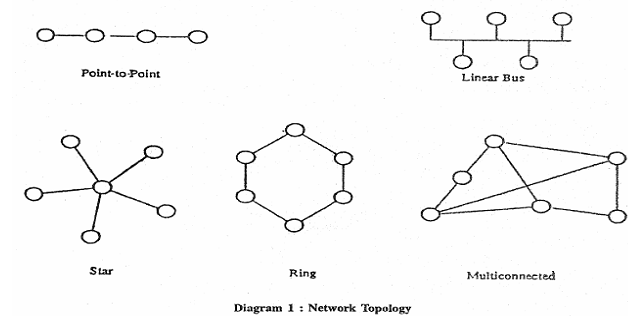Basic Network Topologies
The basic topologies are:
i) point-to-point connection,
ii) linear bus,
iii) Ring connection,
iv) star connection and
v) multiconnected networks.
Let us briefly discuss these.
- Point-to-point connection: It has the advantage of simplifying routing decisions among nodes, but the reliability of the network depends on the reliability of the weakest links.
- Linear bus: In this type of network, all network nodes have unique addresses and are connected' to a common transmission medium. When a device transmits data on to the bus, it is received by all devices and is ignored, except by the one that is addressed. LANs based on the Ethernet use this type of topology.
- Ring Connection in which consecutive nodes are connected by point-to-point links arranged to from a closed path (ring). Information is passed from node to node around the ring until it arrives at the specific node that is addressed.
- Star Connection, in which all nodes are connected to a node called the central node or hub. The central node can be active or passive. If it is active, it is usually used to control the entire network and performs all the routing. This topology is used in applications where a central computer communicates with remote terminals or work stations.
- Multiconnected networks in which nodes are connected by point-to point links in an arbitrary fashion, with each node connected to at least two others. This improves reliability and reduces the likelihood of congestion, but makes routing much more complex since many paths are possible between any two nodes. The above discussed topologies are illustrated in the following diagram.

The second important network parameter as mentioned earlier relates to transmission media. Data transmission media provide the physical communication channel to interconnect nodes in a network. The most commonly used media for computer networks include: i) twisted wire pairs, ii) shielded twisted pain, iii) coaxial cables, iv) optical fibers, v) microwave radio, and vi) satellite links.
Networks usually use a combination of the above media. A corporate network, for example, may use twisted pairs within buildings, optical fibers between local buildings, microwave radio to access buildings within 20 miles range, and satellites to access branches distributed across the nation. Special hardware interfaces are required to interconnect the different media. Generally the wiring within buildings and between buildings on a corporate campus is owned by the corporate enterprise, while the links to distant branches are leased from common carriers such as telephone companies, etc.
It may be stated that the nodes connected by the network include a variety of communication control units that serve as the interfaces between the computing devices and the physical transmission medium over which data are actually transmitted. These control units vary in function and complexity, from a simple ethernet card that connects a personal computer and a local ethernet, to a large front-end processor that performs a variety of complex network functions in front of a mainframe computer. Such control units include devices such as bridges to interconnect local area networks and routers, or gateways:1o interconnect different network architectures using different protocols.